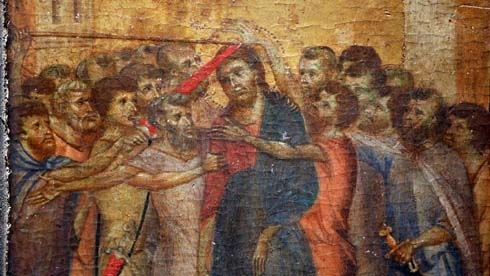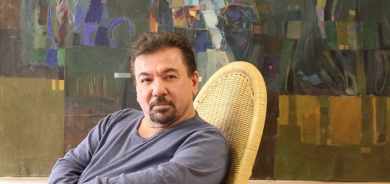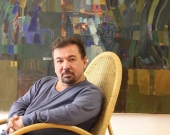Long-lost masterpiece ‘the Holy Grail’ for curators and collectors alike

Early in June, French auctioneer Philomène Wolf showed up at a designer home in the northern town of Compiègne for a routine house clearance. The property’s owner, an elderly woman, had asked Wolf to value her belongings and sift through a pile of junk bound for the dump. Little did she know she was poised to make a discovery that would send ripples of excitement across the art world.
Hiding in plain sight above the bar in an open-plan kitchen, a small wooden panel caught the young auctioneer’s eye. Exquisitely crafted, it was an unsigned painting depicting a scene from Christ’s Passion.
“The lady said she thought it had belonged to her family for a long time, but that it was just a religious icon,” Wolf recalls. “It could well have been destined for the bin.”
The auctioneer thought there was more to the small poplar panel and its vivid portrayal of Jesus surrounded by an angry crowd. Measuring just 24 centimetres by 20 and painted in egg tempera, it bore the hallmarks of the work of late Medieval Italian artists, known in France as primitifs italiens, and appeared to have been sawed off a larger opus.
Following her hunch, Wolf took the painting to Eric Turquin, a prominent Paris-based expert in Old Masters. After examining the find, Turquin’s team stated with “certitude” that its author was none other than Cimabue, the legendary Florentine master whose known works are so rare – and so jealously guarded – they have never been auctioned in modern times.
A giant in art history
The “Mocking of Christ”, Turquin concluded, was part of an eight-part diptych painted by Cimabue around 1280, of which only two other pieces are known: the “Flagellation of Christ”, part of the Frick Collection in New York, and the “Madonna and Child Enthroned between Two Angels”, found under a staircase in an English country house two decades ago and now at the National Gallery in London.
Turquin said there was no doubt about the authenticity of the painting, as it reflected the innovative style pioneered by Giotto’s master.
“We can see the likeness in the facial expressions, the movement and the tentative perspective that define Cimabue’s contribution to art,” said Stéphane Pinta, an art specialist with the Cabinet Turquin in Paris. Furthermore, tests using infrared light prove that tunnels made by woodworms in the panel match those on the other two Cimabue paintings, he added.
“This kind of find is what we wake up for every morning,” said Pinta, hailing “a major discovery” for art historians. “Cimabue is the father of Western art, the one who broke with some of the rules of Byzantine art, introducing the rudiments of expression and perspective.”
Around the world, Cimabue specialists have marvelled at the news.
“This is an extremely unusual discovery,” said Professor Holly Flora, a professor of art history at Tulane University and the author of several works on the Florentine painter. “The number of surviving panel paintings by Cimabue is small – fewer than ten accepted works. So this painting is a hugely important discovery for Cimabue's oeuvre.”
In the artist’s native Florence, Angelo Tartuferi, curator of early paintings at the world-famous Uffizi Galleries, hailed “one of those extraordinary events that can mark a turning point in our knowledge of the history of early Italian painting”. He added: “Cimabue is a giant in the history of Italian art, the greatest painter of the 13th century.”
In the shadow of Giotto
In the beginning, there was Cimabue – or so Giorgio Vasari recounts in his famous “Lives of the Painters”.
The Florentine painter, whose real name was Cenni di Pepo, is the first protagonist of Vasari’s 1550 classic, a survey of three centuries of Italian artistic genius culminating with Michelangelo. Cimabue’s reputation as the forerunner of Renaissance painting owes much to his depiction as such by art history’s precursor.
Wrecked by war and disease, Italy was a field of ruins when, “in the year 1240, there was born in the city of Florence, Giovanni, surnamed Cimabue […], who was to shed the first light on the art of painting,” Vasari wrote. His pupil’s light would shine brighter, however, until “Giotto truly eclipsed Cimabue’s fame.”
The story had been told before, by another illustrious Florentine. In the Divine Comedy, begun shortly after the painter’s death, Dante observed: “In painting Cimabue thought he held the field but now it’s Giotto has the cry, so that the other’s fame is dimmed.”
A detail of Cimabue's "Maestà" housed at the Louvre in Paris. Wikimedia creative commons
That narrative has stuck ever since, says Professor Flora.
“Renaissance writers considered him the harbinger of the Renaissance whose genius paved the way for the more famous Giotto,” she explained, adding that Cimabue should “be appreciated for his own inventiveness and not just as a prelude to Giotto”.
While traditional scholarship has focused on the painter’s stylistic innovations, most notably his departure from the rigid traditions of Byzantine art to introduce delicately-shaded facial expressions to breathe life into his characters, Professor Flora has stressed the message conveyed by the artist.
Cimabue “collaborated with powerful patrons, the Franciscans foremost among them, to revolutionise narrative devotional art at the end of the thirteenth century,” she said. “This panel is part of a smaller devotional work, probably made for Franciscan patrons, that demonstrates Cimabue's contributions to a newly heightened, emotional experience of the life of Christ.”
‘Attic of the world’
Whether or not scholars and the general public will be able to experience this firsthand will depend on the outcome of an auction scheduled for October 27 in the town of Senlis, north of Paris. Turquin and the Acteon auction house, the event’s joint organisers, expect it to fetch well over 4 million euros.
"The Mocking of Christ", attributed to Cimabue, is on display at the Turquin gallery in Paris. Philippe Lopez, AFP
Tartuferi, of the Uffizi Gallery, says a work of such importance should be looked after and displayed in a major museum for the benefit of all. He suggests the auction’s location in France will give the Louvre a headstart in what is likely to be a hugely competitive field.
“I doubt our French friends will let this opportunity to augment the Louvre’s already fabulous collection of Italian paintings slip away,” he said, remarking in jest: “I wish this painting had turned up in a kitchen in Rome or Pisa.”
The Louvre already possesses one of Cimabue’s most famous paintings, a sumptuous “Maestà” taken from the church of San Francesco in Pisa during Napoleon’s occupation of Italy. But Pinta, of the Cabinet Turquin, says the coveted artwork is just as likely to whet the appetites of wealthy private collectors, for whom Old Masters are increasingly “the Holy Grail”.
The Cimabue find is the second such discovery of a lost masterpiece by one of western art’s biggest names in recent years. In 2014, a painting of “Judith and Holofernes” was found under a mattress in an attic in Toulouse and attributed to Caravaggio – also by Turquin. Valued at more than €100m, it was eventually snapped up by an unknown foreign buyer, though some Italian experts had doubts about the canvas.
“France is sometimes referred to as the world’s attic,” says Pinta. “We’ve been spoilt by a wealth of artists and collectors who have come here over the centuries,” adds the art expert, blaming bouts of iconoclastic violence, particularly during the French Revolution, for the subsequent loss and scattering of precious treasures.
“A lot of artworks have been lost,” he says. “And that is why we are here.”
France24















